Physical Address
304 North Cardinal St.
Dorchester Center, MA 02124
Physical Address
304 North Cardinal St.
Dorchester Center, MA 02124

Ever felt a sharp pain when reaching for something high or swinging a racquet? It’s a pain that can stop you right in your tracks. This could be AC joint pain, where your collarbone meets your shoulder blade. It’s a sign that something’s not right or off in your shoulder.
Understanding shoulder pain treatment is key for our overall well-being. Whether you’re active or work with your hands, AC joint pain is more than a nuisance. It starts with stiffness and grows into a constant ache, showing signs of AC joint inflammation or separation. For athletes, it can even end their careers and passions.
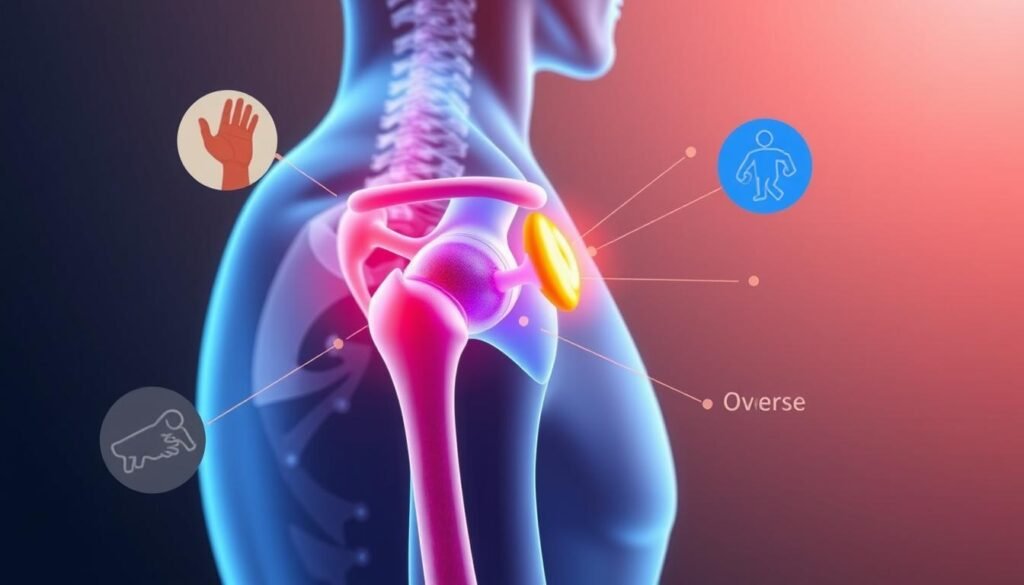
Talking about AC joint pain isn’t complete without mentioning injuries. AC arthritis is common in older adults1. Factors like age, family history, and past injuries make you more likely to get it12. Every snap or click is a sign of worsening pain and joint function1. If ignored, it can limit your functional abilities beyond just your shoulder1.
The acromioclavicular (AC) joint is key in the shoulder’s mechanics. It helps with many arm movements. Knowing about this joint’s anatomy and role is important for injury recovery.
The AC joint connects the clavicle’s end to the scapula’s acromion. It’s held together by two ligaments: the acromioclavicular and coracoclavicular ligaments. These ligaments help the shoulder move and stay stable. People who lift heavy things often get injuries here, especially weightlifters3.
The AC joint lets us move our arms up and across our body. Injuries here, which are common, can make it hard to move and might need special rehab4. Most separations can heal without surgery, but some will end up needing it3. Rehab helps people get back to their usual activities after surgery3.
Understanding the AC joint’s role in the shoulder is crucial for recovery. Knowing about the acromioclavicular and coracoclavicular ligaments is key for successful rehab.
| Injury Severity | Typical Recovery Time | Surgery Requirement |
|---|---|---|
| Grade 1 AC Joint Separation | 10 to 14 days | Rarely |
| Grade 2 AC Joint Separation | Variable | Sometimes |
| Grade 3 AC Joint Separation | 6 to 8 weeks | Generally for severe cases |
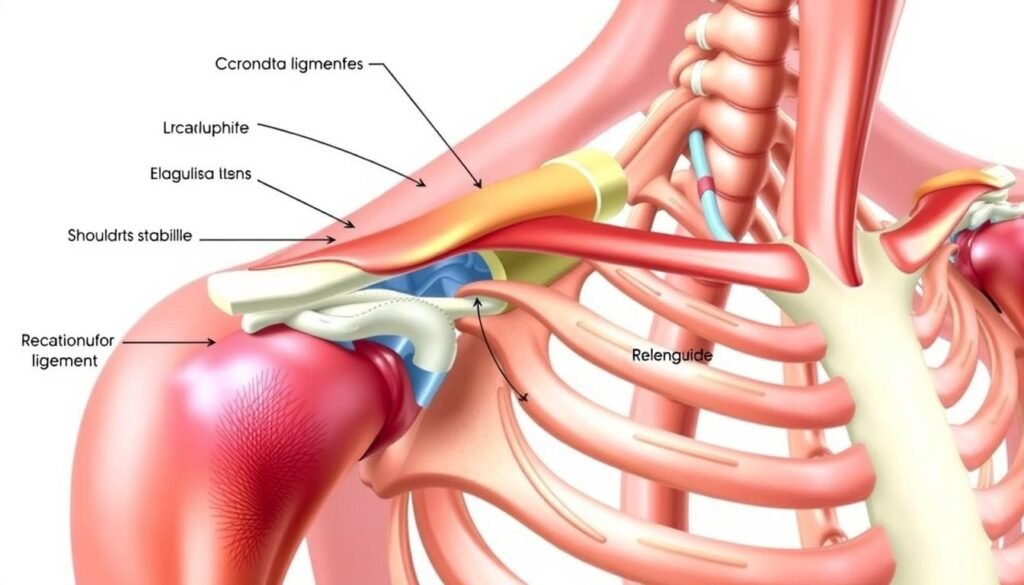
Knowing the signs of AC joint pain is key to managing it. Pain at the top of the shoulder is a common symptom. It gets worse with overhead lifting or sleeping on the affected side5. People who do a lot of overhead work, like in sports or construction, are especially at risk5.
Other symptoms include swelling and less shoulder motion5. A doctor can diagnose AC joint pain by feeling the joint5. They also check for pain when the joint is pressed5.
If you’re feeling these symptoms, see a doctor. They might take an X-ray to check for joint narrowing or bone spurs5. To manage pain, avoid activities that make it worse. Use painkillers and do exercises to help your shoulder6.
Learn more about exercises for AC joint pain at this link. Doing these exercises can really help your shoulder feel better and improve your life.
| Management Technique | Benefit | Duration |
|---|---|---|
| Physiotherapy | Improves movement, reduces pain | 4-6 weeks6 |
| Ultrasound-guided injections | Quick pain relief | Varies |
| Strength training & stretching | Increases joint stability and function | Ongoing |
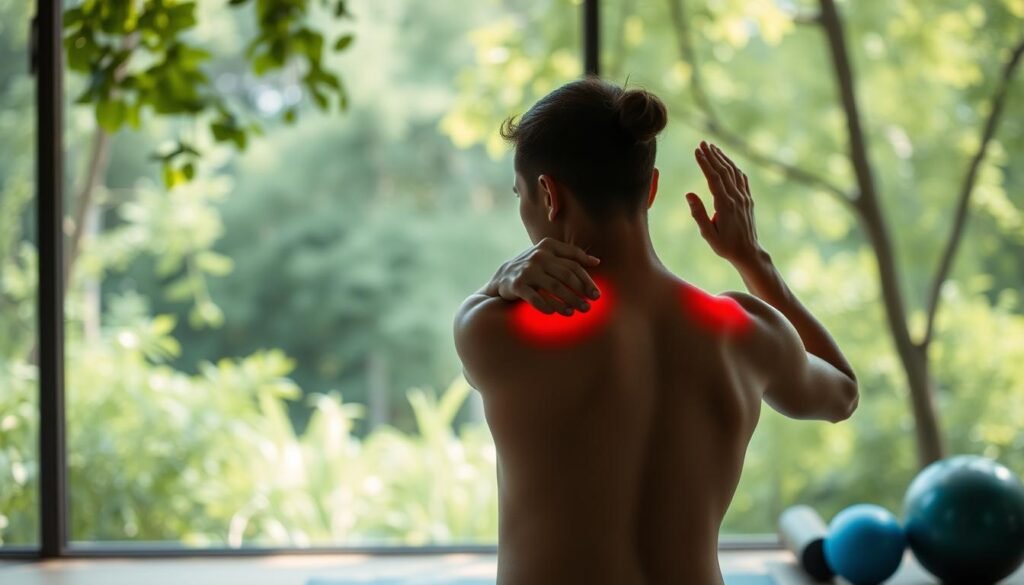
Recovery can take 4-6 weeks, but it depends on the person and their treatment6. It’s important to stick with the treatment plan to get the best results.
Acromioclavicular (AC) joint injuries are a big worry for athletes. They often lead to long-lasting shoulder pain and inflammation. Knowing about these injuries helps in preventing and treating them, especially for those in high-impact sports.
AC joint sprains and shoulder separations usually happen from impacts or falls on the shoulder. This is common in sports like football and rough cycling terrains. These incidents can damage the ligaments around the AC joint, causing shoulder separation.
AC joint injuries are ranked from Type I to VI, with severity increasing. Type I is the least severe, and Type VI is the most severe, with the joint completely out of place7.
Doing the same physical activities over and over can stress the AC joint ligaments too much. This stress, combined with sudden impacts, can cause ligament tears. This leads to inflammation and conditions like osteoarthritis in older athletes.
Interestingly, males in their 20s and 30s are most often affected by these injuries. This is especially true for sports that involve a lot of falls, like skiing or snowboarding8.
| Sport | Common Injury Type | Treatment Approach |
|---|---|---|
| Football, Cycling | AC Joint Sprain (Type I-III) | Conservative |
| Skiing, Snowboarding | Ligament Tear/Shoulder Separation (Type IV-VI) | Surgical Intervention |
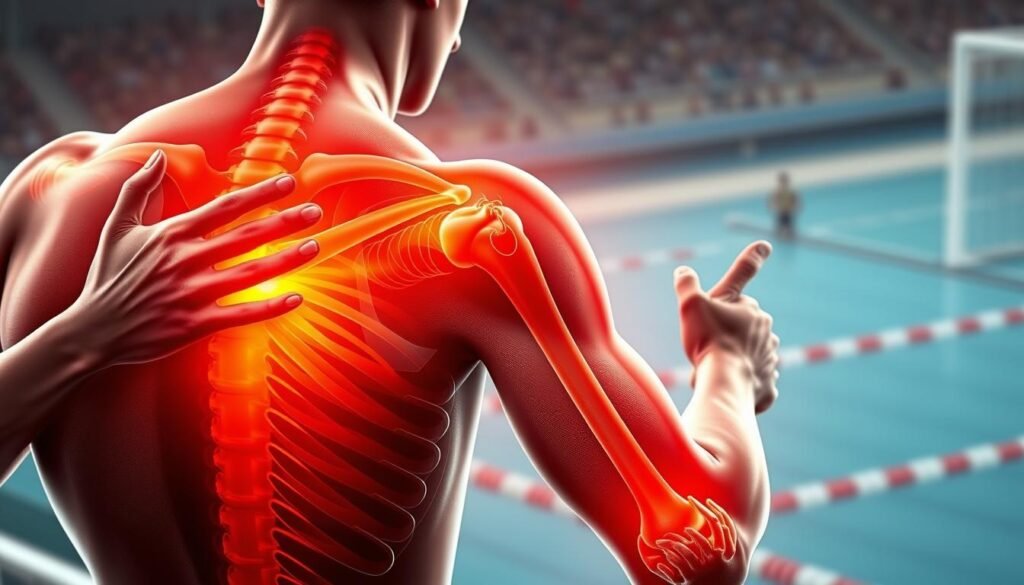
In conclusion, both sudden impacts and repeated stress are key factors in AC joint injuries among athletes. It’s important to have preventive and responsive measures in place. By understanding the risks and injury mechanisms in sports, we can reduce shoulder separations and ac joint inflammation78.
When it comes to AC joint injuries, we use the latest diagnostic tools. These tools are key to finding the right treatment. Shoulder injuries are common, especially among those who are active. Knowing the exact injury is crucial for effective treatment.
Physical exams are the first step in diagnosing AC joint injuries. The AC joint compression test checks for pain and limited movement. It’s especially important for men aged 20 to 30, as they often experience sharp pain and reduced mobility.
X-rays and MRI scans help us see the injury in detail. They show both bones and soft tissues. X-rays take different views to assess the AC joint thoroughly. MRI scans are key for injuries caused by high-energy forces.
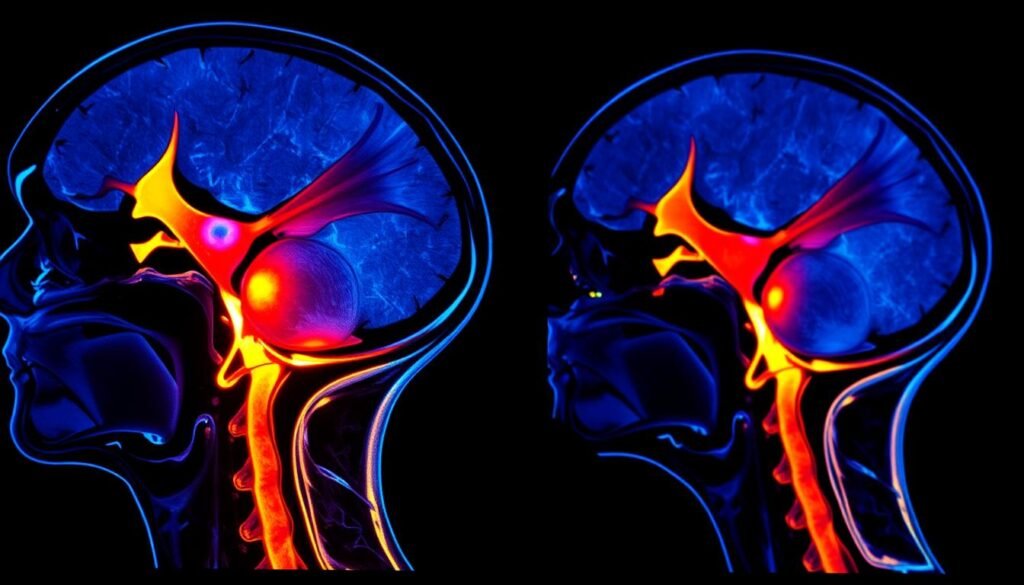
| Diagnosis Method | Utility | Common Findings |
|---|---|---|
| Physical Examination | Initial assessment | Pain, swelling, reduced mobility |
| AC Joint Compression Test | Specific for AC joint assessment | Extreme pain indicative of joint issues |
| X-Ray | Details bone integrity | Fractures, misalignments |
| MRI Scan | Details soft tissue integrity | Intra-articular pathologies, SLAP lesions9 |
AC joint injuries can be tough to deal with. Accurate diagnosis is key for recovery. Using these detailed diagnostic methods helps manage pain and aids in rehabilitation. This way, patients can get back to their daily lives faster.
For those facing AC joint injuries, effective treatment is crucial. Our approach integrates the latest research and clinical insights to offer the best outcomes for recovery.
Initially, shoulder injury rehab starts with non-surgical methods. Rest, ice, and immobilization are critical first steps to prevent further damage and aid with initial pain management. Modifications in daily activities are also recommended to relieve stress on the injured joint. A study by LeVasseur et al. in 2021 reveals that immobilization for an AC joint sprain is typically maintained for 3 to 10 days, with many patients choosing to discontinue when they no longer experience pain10.
Physical therapy plays a pivotal role in the recovery process, focusing on shoulder pain relief exercises aimed at restoring mobility and strength. These exercises usually begin with gentle range-of-motion movements such as shoulder flexion and external rotation. Importantly, strengthening exercises should commence within the first week post-injury, guided by symptom tolerance, and should not cause significant pain during or after execution10.
For more severe cases, categorized as Types 4, 5, and 6 in the Rockwood classification system, surgical intervention may be considered. However, as found by a Cochrane review in 2019, surgery does not necessarily enhance shoulder function, return to activity, or quality of life at one year for these injury types, underlining the necessity of carefully weighing treatment options10.
| Treatment Approach | Initiation Time | Expected Recovery Duration |
|---|---|---|
| Initial Immobilization | Immediately after injury | 3-10 days |
| Physical Therapy | 1 week post-injury | Varies based on injury severity |
| Surgical Intervention (if necessary) | After conservative measures | Long-term, varies widely |
Moreover, maintaining a correct sitting posture and utilizing ergonomic supports can further assist in the shoulder pain treatment process, particularly during the rehabilitation phase for those recovering from surgery or significant injuries.
We recognize each patient’s journey through rehabilitation is unique, influenced by factors such as the type of injury and individual pain thresholds. Ongoing evaluation and tailored adjustments to the therapy program are essential to ensure the best possible recovery outcomes, striving towards optimal shoulder functionality and the prevention of future injuries.
We’ve looked closely at acromioclavicular (AC) joint pain. It’s a common problem that can really hurt. In adults, ACJ pain happens to 0.5 to 2.9/1000/year in primary care11. This shows how common it is and why we need good ways to manage it.
Many things can cause ACJ pain, like falls or direct hits. Osteoarthritis is a big reason for long-term pain because it puts stress on the joint11.
Doctors use special tests and scans to find the problem. They look for tenderness and use the Paxinos test to check for ACJ pain11. Physical therapy is key in getting better without surgery. It helps with pain and getting back to normal.
But sometimes, surgery is needed, especially after big injuries. Removing part of the clavicle can help a lot11. Even though surgery can be tough, it can really improve life. With the right care and therapy, people can get back to their usual activities or sports.
AC joint pain often shows as tenderness and discomfort at the shoulder’s top. You might also see swelling and feel like your range of motion is reduced. Pain gets worse when lifting your arm up or sleeping on the affected side.
Several things can cause AC joint pain. This includes a shoulder separation, arthritis, or osteolysis. Overuse, trauma, or repetitive stress injuries from sports can also lead to it.
The acromioclavicular joint is where the clavicle meets the acromion. It’s supported by ligaments. This setup helps with shoulder movement and keeps the joint stable.
An AC joint sprain, or shoulder separation, happens when the ligaments stretch or tear. It often results from direct impacts, falls, or sudden movements.
Doctors start by doing a physical exam, which might include the AC joint compression test. They then use X-rays to check for fractures and MRI scans for soft tissue damage.
Treatment depends on the injury’s severity. It can include rest, ice, and immobilization. You might also need to change your activities, do physical therapy, or in severe cases, have surgery.
Yes, physical therapy is key for AC joint injury recovery. It helps with pain relief, restores movement, and strengthens the shoulder. It ensures the joint becomes stable and functional again.
No, surgery isn’t always needed. Many injuries can be treated with medication, physical therapy, and lifestyle changes. But, severe cases or chronic conditions might need surgery.